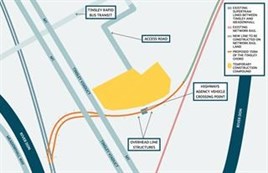Network Rail has unveiled its planned route for a 150-metre chord linking the heavy rail and Sheffield Supertram networks. The chord will be used by tram-trains running between the two systems.
Warrick Dent, area director for Network Rail, said: “Even though the tram-trains run elsewhere, we have had many complex issues to work through with our partners in the project, to make sure that the vehicles can operate safely in Britain without causing unnecessary disruption to regular tram and rail passengers.”
Consultation events are being held at The Skills Source Academy in Sheffield on February 6/7.
Tram-trains will provide a direct service and improve journeys between Sheffield city centre, Rotherham Central and Parkgate retail park. They will use the existing Supertram route between Cathedral and Meadowhall South and then run onto the rail network via the new chord to Parkgate.
The chord needs 150 metres of track, overhead line equipment and lineside equipment, including a small new building to house electrical equipment.
An application for a Transport and Works Act Order (TWAO) will be submitted to the Secretary of State for Transport in spring 2015, and there will be a further public consultation as part of this process. Dependent upon the TWAO process and decision, work to construct the chord is expected to start in spring 2016.
Vossloh is building the tram-trains, with delivery due later this year.
- For more on this story, see RAIL 768, published on February 18.















Login to comment
Comments
Andrew Grimes - 15/02/2015 11:41
If the Sheffield tram- train project is an evaluation project surely the planners should focus on the long term issues of this model such as potential need for dual voltage and separating pedestrians from heavy rail. NET, Midland Metro and Newcastle Metro already share track bed with National Rail and have sorted out differences in platform and track access. Even London Tramlink and Network Rail solved these problems at Mitcham Junction. I don't see why the new cord is necessary when a third platform at the tramstop and double tracking the bridge would do it for a lower cost and would test segregation solutions. I do think that the issue of dual voltage is worth considering especially as longer tram lines would suffer greater energy losses at 1500 volts dc.